No matter where you’re spending your marketing dollars, you’ll want to know if you’re getting a good return on your investment. But the metrics you track for email or paid search ads aren’t going to be the same metrics you want to track when it comes to social media. In this article, we’re going to share 12 of the most important social media metrics you should be tracking—beyond mere vanity metrics—to ensure that your social media marketing is hitting the mark.
Even if you don’t run paid social media ads, you’re putting resources into creating the content that you post across social media platforms. If you’re not tracking the right social media metrics, including the use of powerful Social Media Scheduling Tools, you have no idea if your resources are being put to good use. Understanding your social media marketing performance is going to help you improve your social media marketing strategy so you can increase followers, boost engagement, and get more sales and conversions.
With more than 3.4 billion active social media users across platforms spending nearly 2.5 hours on social media every day, it’s important to have an effective social media strategy that continues to evolve as new platforms come onto the scene and existing platforms release new features, updates, and marketing tools.
Why Social Media Metrics Matter
Social media metrics are what tell you if you’re hitting your goals. And no matter your goals, you’ll find a social media metric that you can use to make sure you’re achieving it. These metrics are an indication of how your strategy is performing so you can make adjustments as needed. For example, if you want to increase engagement, you can look at metrics like comments, shares, clicks, and likes to determine if you’re meeting that goal.
Also, if you’re handling social media marketing for a boss or client, metrics offer up quantifiable proof that your campaigns are performing as promised. Every article you read about social media marketing is going to dole out advice about how to track your strategy’s success with social media metrics. There are 3 problems with much of the advice out there.
- They don’t take your business goals into consideration
- There’s usually an emphasis on increasing metrics instead of using metrics as a gauge of how well you’re reaching your target audience
- Vanity metrics are typically held up as the only measure of success
To find out if your social media marketing strategy is performing well, though, you need to move beyond vanity metrics. Here are 12 social media metrics we’ve found to be the best measures of social media performance. We’ve broken them down based on the different stages of a typical social media marketing funnel:
- Awareness social media metrics
- Share of Voice (SOV) social media metrics
- Engagement social media metrics
- Conversion social media metrics
- Customer social media metrics
12 Social Media Metrics You Should Be Tracking:
- Awareness Social Media Metrics: Impressions and Reach
- Share of Voice Social Media Metrics: Volume and Sentiment
- Engagement Social Media Metrics: Likes, Comments, Shares, and Clicks
- Conversion Social Media Metrics: Referrals, Conversions, and Click-through Rates
- Customer Social Media Metrics: Testimonials, Satisfaction, and NPS
Awareness Social Media Metrics: Impressions and Reach
Impressions and reach are two social media metrics that help you understand your current and potential audience and how aware they are of your brand. These metrics are particularly important if your social media marketing goals center on brand awareness and brand perception.
Impressions
Impressions are simply how many times a post shows up in users’ timelines.
Reach
Reach is the number of unique viewers a post has (or could have). This is typically your follower count plus the follower counts of the accounts that shared the post.
These social media metrics are best used in conjunction with other metrics to get a better overall view of how your social media content is performing. If you’re interested in increasing awareness of a specific marketing message, for example, looking at a combination of impressions and engagement (likes, shares, etc.) will be much more telling than looking at those metrics separately.
If you have high reach and high engagement, you’ve found a winning message. If you have high impressions but low engagement, your post didn’t inspire your followers to action.
Share of Voice Social Media Metrics: Volume and Sentiment
Share of Voice in social media is how much of the market your brand owns compared to your competitors. There are two social media metrics we’re going to look at for Share of Voice: volume and sentiment. There are social listening tools that can make measuring Share of Voice a lot easier and less time-consuming.
Volume
Volume tells you how many people are talking about your brand, content, or industry on social media. This includes counts of how many times your username is tagged, you’re mentioned in a social media post without being tagged, or when your brand (or branded/related terms) is used in a hashtag.
When you’re not being talked about, it can mean a couple of different things. Either your message isn’t reaching your target audience or your message isn’t right for your target audience.
Sentiment
Sentiment is a measure of the feelings, opinions, and attitudes consumers have and express about your brand on social media. Where volume tells you “how many,” sentiment gets into the context of your mentions, shares, and comments. Positive sentiment about your brand should be your goal.
There are a few benefits of tracking social media sentiment for your brand. First, knowing how your message is being received makes it a lot easier to take corrective measures if something goes wrong with your message. Next, it helps support customer service activities since you’re able to identify negative sentiment and address it before it spreads. Finally, you can analyze sentiment for your competitors’ messaging and use that to inform your own brand messaging.
The easiest way to track volume and sentiment is through social listening. Here are the best social media listening tools on the market right now.
Engagement Social Media Metrics: Likes, Comments, Shares, and Clicks
Engagement metrics like comments, shares, clicks, and likes show how many people are interacting with your content. Engagement is a pretty big category of social media metrics and tends to be the only thing that those new to social media marketing track. When tracked alone, however, engagement metrics don’t provide much real value; they’re mostly vanity metrics.
That’s not to say that vanity metrics are entirely without value. According to the Content Marketing Institute, the value of a vanity metric lies in measuring non-transactional marketing goals like brand awareness, sentiment, and share of voice in addition to optimizing social media campaigns and troubleshooting marketing problems. High engagement rates can also tell you how responsive your audience is and give you an indication of how many active and engaged followers you have.
Engagement Rate
Engagement rate is the number of engagements with your content divided by either impressions or reach. A high engagement rate means that the people who saw the post find it interesting.
Likes, Shares, Comments, and Clicks
These are individual engagement metrics that add up to give you a total number of engagements for your posts or profile.
Looking at a single engagement metric isn’t going to give you the context you need to make educated decisions about your social media marketing strategy. We encourage you to analyze a combination of metrics including engagement metrics but not solely focusing on these metrics.
It’s also important to remember that not all of your posts will require engagement. For example, if you post something purely for informational or aesthetic purposes it might not matter to you if it has low engagement. On the other hand, if you’re getting low engagement on posts where there is a call to action it’s a signal that something about your post needs to be adjusted. At that point, you can test the same post with a different call to action or trying a new post with the same caption to see what works.
Conversion Social Media Metrics: Referrals, Conversions, and Click-through Rates
Conversion metrics like referrals and conversions show you the effectiveness of your engagement. While “conversions” tends to mean “purchases” to many, it can really be anything that you are asking your followers to do. Hands down the easiest way to track both referrals and conversions is by using analytics software like Google Analytics or Mixpanel.
Referrals
Referrals are how visitors get to your website. In your web analytics software, you’ll see referrals broken down into sources. For social media, you’ll be monitoring the “Social” source which you can then drill down into to find referral data for specific social media platforms.
Conversions
Conversions happen when someone buys something from your site or completes an action that you’ve requested (like registering for a webinar or signing up for your email list). A social conversion means that the visitor came to your site through social media and then converted in that same visit.
Click-through Rates
Click-through rate is the number of clicks you receive divided by the number of times your post is shown. So, if you had 5 clicks and 100 impressions, your CTR is 5%. When your CTR is high, it’s a pretty safe bet that your post is effective.
Customer Social Media Metrics: Testimonials, Satisfaction, and NPS
Customer social media metrics reflect how your current, active customers feel about your brand. We’re specifically going to talk about testimonials, customer satisfaction (CSat), and net promoter score (NPS).
Testimonials
Testimonials are any customer review, rating, or endorsement for your brand. Testimonials are great social proof that signal to potential customers that your current customers are happy with your products and services. This goes a long way toward boosting your brand’s credibility and inspiring trust.
Customer Satisfaction
Customer satisfaction (CSat) shows how happy people are with your products and services. To calculate CSat, brands ask customers a single question: “How would you describe your overall satisfaction with this product or service?” From there, customers rate their satisfaction on a linear scale numerically (on a scale from 1–10, for example) or sentimentally (using descriptors like “poor,” “good,” and “excellent”).
Net Promoter Score
Net Promoter Score (NPS) measures customer loyalty and, unlike CSat, is a good way to predict future customer engagement. Similar to CSat, customers are asked a single question. For NPS, that question is “How likely is it that you would recommend our company/product/service to a friend?” From there, customers use a 0–10 scale to answer. This can be used by your brand to place respondents into specific groups:
- Detractors are those providing a rating between 0–6.
- Passives provide a rating of 7 or 8.
- Promoters provide a rating of 9 or 10.
You can then use this information to reach out to those in the Promoters category to turn them into brand evangelists.
Track the Social Media Metrics That Matter
As you can see, there are many social media metrics you can track. With so many metrics available, it can be a bit confusing to find the metrics that are going to help you reach your social media marketing goals. While the social media metrics we’ve included here aren’t the only metrics you can track, they are the best metrics we’ve found to work for most brands.
Ultimately, it comes down to your goals. Of the 12 social media metrics we’ve outlined, you may decide to track only a few. And that’s fine. The purpose of analyzing the impact of your social media is so you can make smarter decisions for your brand, so choose the metrics that will best help you meet your goals and get the most from your social media marketing efforts.
The most important thing is to focus on actionable social media metrics that show you how your audience is engaging with your content. As you can imagine, manually tracking your social media metrics can be an overwhelming task. And, while each social media platform likely has its own native analytics tools, it really helps to have a social media analytics tool that will let you analyze the entirety of your social media marketing efforts.

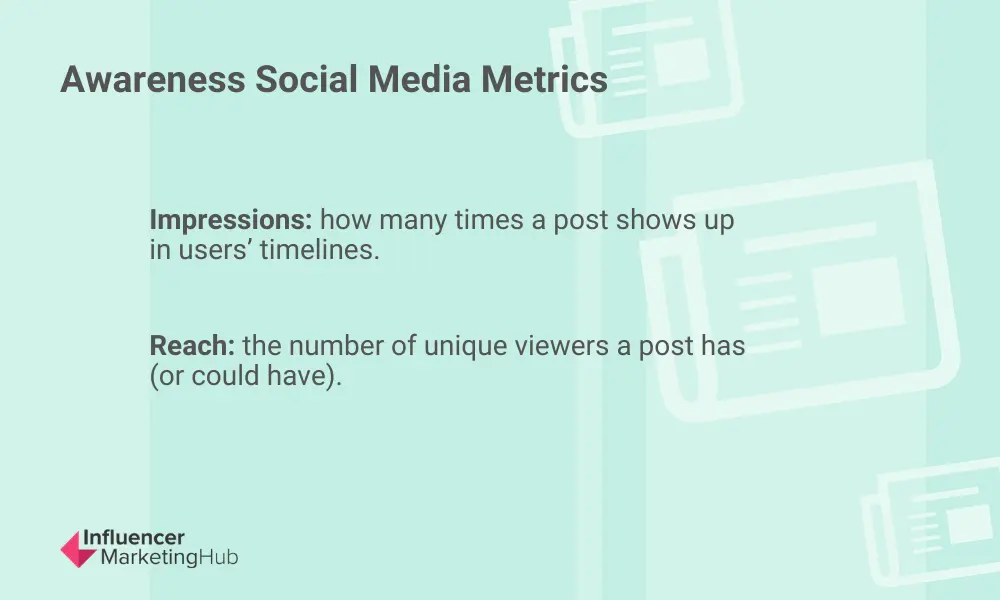
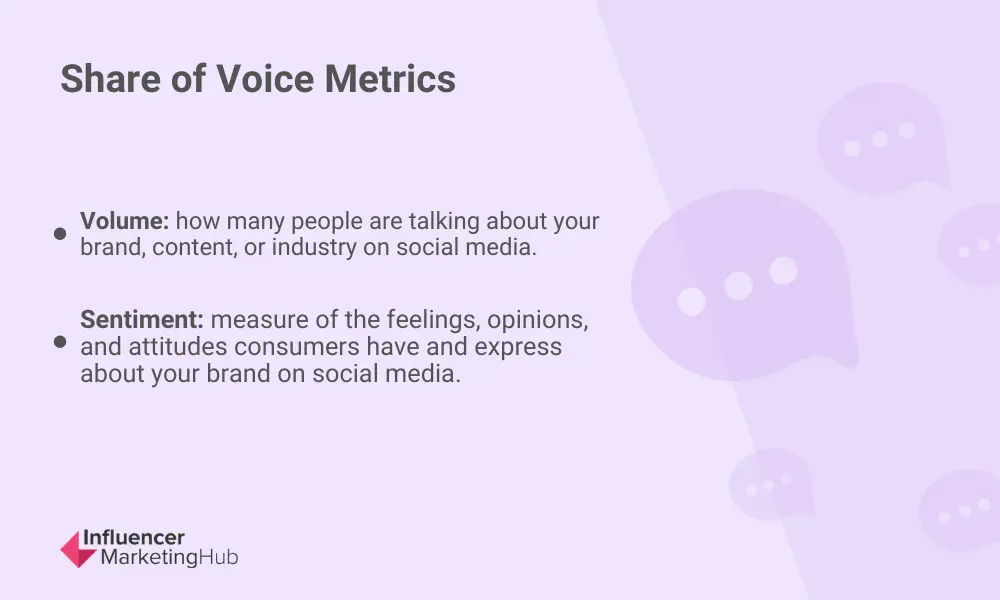
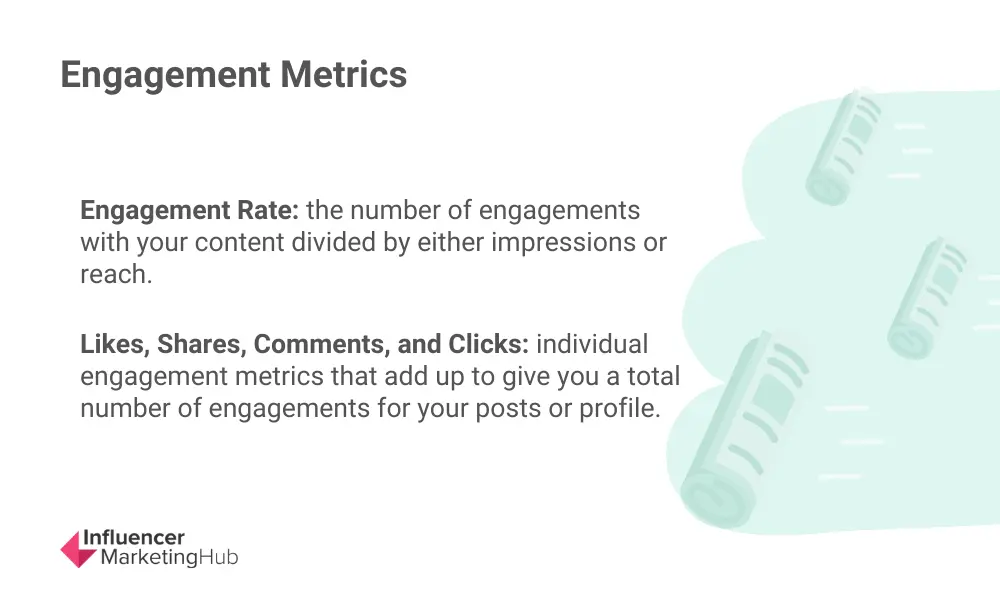
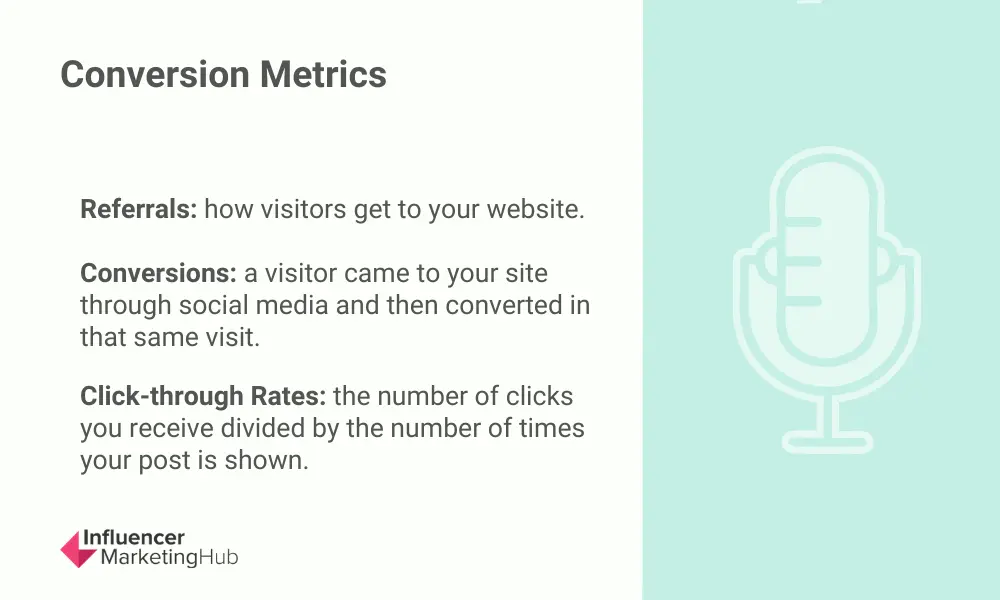
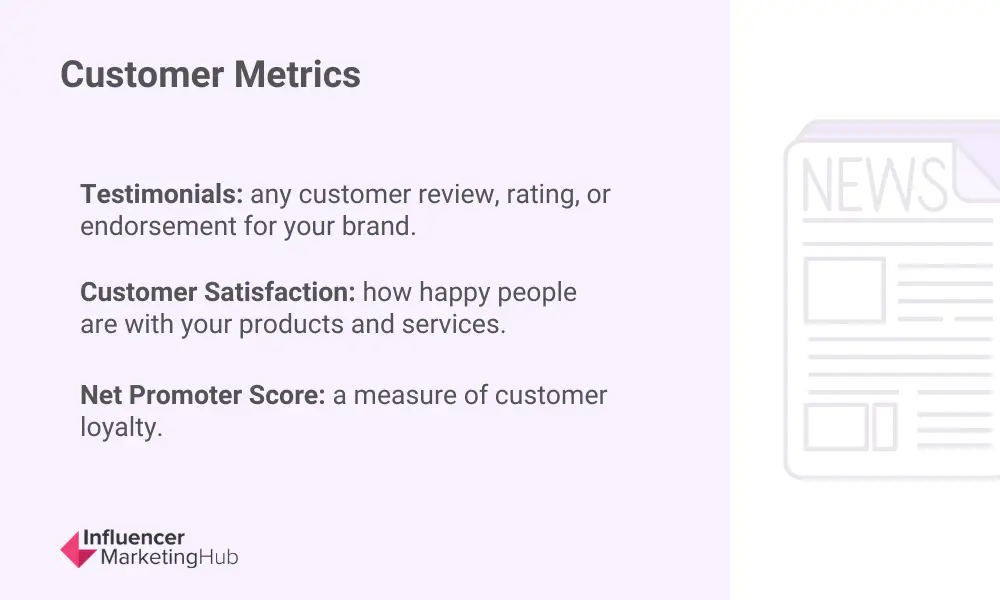


![Create a Powerful Social Media Strategy in 10 Steps [+ Free Template]](https://s.influencermarketinghub.com/imaginary/resize?width=400&height=200&type=webp&url=https://influencermarketinghub.com/wp-content/uploads/2018/11/20-Step-Social-Media-Marketing-Strategy-for-Businesses-in-2022.png)